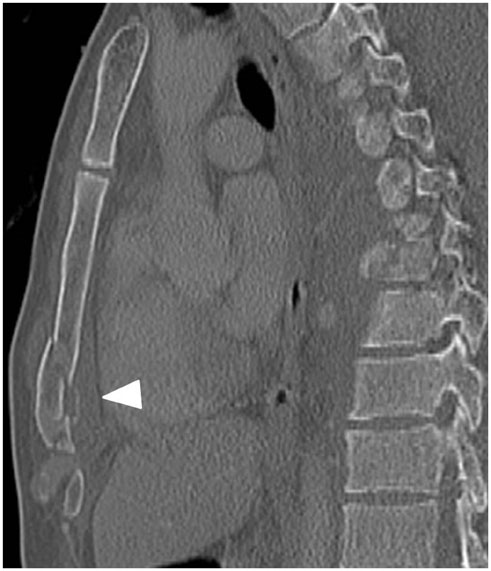J Korean Soc Radiol.
2015 May;72(5):305-312. 10.3348/jksr.2015.72.5.305.
Traumatic Sternal Fracture: Incidence, Causes, and CT Features
- Affiliations
-
- 1Department of Radiology, Soonchunhyang University College of Medicine, Cheonan Hospital, Cheonan, Korea. ytokim@schmc.ac.kr
- KMID: 1793885
- DOI: http://doi.org/10.3348/jksr.2015.72.5.305
Abstract
- PURPOSE
To evaluate the incidence of sternal fracture due to trauma, the CT features of sternal fractures, and the hospitalization period.
MATERIALS AND METHODS
The medical records and CT images of 755 patients who suffered trauma from January 2012 to August 2013 were analyzed retrospectively. We compared the incidence of sternal fracture due to various traumatic causes. We evaluated the location and shape of the sternal fracture on CT scans and the relationship between a sternal fracture and the hospitalization period.
RESULTS
The incidence of sternal fracture was 9.27% (70/755) in all patients; 11.7% (53/453) due to a traffic accident (TA), and 5.63% (17/302) due to other causes. TA was the most frequent cause (75.71%) of a sternal fracture, fracture incidences after a TA differed by traumatic cause (p < 0.05). Among sternal fractures, the body was the most commonly involved (68.57%), one wall was limited (32.85%), and anteroposterior length increased (7.14%). Body fractures involving two or more segments included 33.33% of the cases. The hospitalization period was not related with sternal fracture (p = 0.30).
CONCLUSION
fracture was more frequent after a TA than due to other causes. Fracture incidences after a TA depended on the traumatic causes. Involvement of two or more segments and one wall-limitation were common among sternal fractures. Sternal fractures occurred even in slightly injured patients.
MeSH Terms
Figure
Reference
-
1. Goodman LR, Teplick SK, Kay H. Computed tomography of the normal sternum. AJR Am J Roentgenol. 1983; 141:219–223.2. Stark P, Jaramillo D. CT of the sternum. AJR Am J Roentgenol. 1986; 147:72–77.3. Restrepo CS, Martinez S, Lemos DF, Washington L, McAdams HP, Vargas D, et al. Imaging appearances of the sternum and sternoclavicular joints. Radiographics. 2009; 29:839–859.4. Budd JS. Effect of seat belt legislation on the incidence of sternal fractures seen in the accident department. Br Med J (Clin Res Ed). 1985; 291:785.5. Otremski I, Wilde BR, Marsh JL, McLardy Smith PD, Newman RJ. Fracture of the sternum in motor vehicle accidents and its association with mediastinal injury. Injury. 1990; 21:81–83.6. Porter RS, Zhao N. Patterns of injury in belted and unbelted individuals presenting to a trauma center after motor vehicle crash: seat belt syndrome revisited. Ann Emerg Med. 1998; 32:418–424.7. Stark P. Radiology of thoracic trauma. Invest Radiol. 1990; 25:1265–1275.8. Harley DP, Mena I. Cardiac and vascular sequelae of sternal fractures. J Trauma. 1986; 26:553–555.9. Aslam M, Rajesh A, Entwisle J, Jeyapalan K. Pictorial review: MRI of the sternum and sternoclavicular joints. Br J Radiol. 2002; 75:627–634.10. Hills MW, Delprado AM, Deane SA. Sternal fractures: associated injuries and management. J Trauma. 1993; 35:55–60.11. von Garrel T, Ince A, Junge A, Schnabel M, Bahrs C. The sternal fracture: radiographic analysis of 200 fractures with special reference to concomitant injuries. J Trauma. 2004; 57:837–844.12. Huggett JM, Roszler MH. CT findings of sternal fracture. Injury. 1998; 29:623–626.13. Kim EY, Yang HJ, Sung YM, Hwang KH, Kim JH, Kim HS. Sternal fracture in the emergency department: diagnostic value of multidetector CT with sagittal and coronal reconstruction images. Eur J Radiol. 2012; 81:e708–e711.14. Im DJ, Hahn S, Kim YJ. The usefulness of sagittal reformation for diagnosis of sternal fracture. J Korean Soc Radiol. 2014; 70:25–30.15. Scaglione M, Pinto A, Pedrosa I, Sparano A, Romano L. Multi-detector row computed tomography and blunt chest trauma. Eur J Radiol. 2008; 65:377–388.16. Oyetunji TA, Jackson HT, Obirieze AC, Moore D, Branche MJ, Greene WR, et al. Associated injuries in traumatic sternal fractures: a review of the National Trauma Data Bank. Am Surg. 2013; 79:702–705.17. Helal B. Fracture of the manubrium sterni. J Bone Joint Surg Br. 1964; 46:602–607.18. Arajärvi E, Santavirta S. Chest injuries sustained in severe traffic accidents by seatbelt wearers. J Trauma. 1989; 29:37–41.19. Hamilton JR, Dearden C, Rutherford WH. Myocardial contusion associated with fracture of the sternum: important features of the seat belt syndrome. Injury. 1984; 16:155–156.20. Johnson I, Branfoot T. Sternal fracture--a modern review. Arch Emerg Med. 1993; 10:24–28.21. Recinos G, Inaba K, Dubose J, Barmparas G, Teixeira PG, Talving P, et al. Epidemiology of sternal fractures. Am Surg. 2009; 75:401–404.
- Full Text Links
- Actions
-
Cited
- CITED
-
- Close
- Share
- Similar articles
-
- Treatment of Traumatic Sternoclavicular Joint Anterior Dislocation with a Sternal Fracture
- Erratum: Traumatic Sternal Fracture: Incidence, Causes, and CT Features
- Clinical Evaluation of Traumatic Sternal Fracture
- Remodeling of Traumatic Sternal Segment Dislocation in a 13-Year-Old Boy
- Factors Associated with Skeletal Chest Injuries Secondary to Cardiopulmonary Resuscitation of In-Hospital Cardiac Arrest Patients





